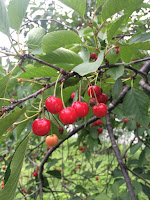December—An End and a Beginning
December is the month of dwindling daylight. I understand why so many animals hibernate or semi-hibernate. It feels as if everything is coming to an end. The growing season is ending; the world is ending. Okay, an exaggeration. But dark at 4:30? The rainy and gray days take a toll on everyone. The plants outside just sit there…not dying, not growing. Our calendar year is ending, which is a natural time to look back over the year and assess what went as planned, what did not, what was successful, what was not, what do we want to do differently? And then--what a relief to get past the Winter Solstice and start increasing our daylight, minute by precious minute. And because growing is what I like most of all, we look at ways to circumvent nature and winter weather. The trees and fruit bushes will stay dormant, but growing vegetables in the high tunnels and heated greenhouses is rewarding. The greenhouses are warmed with passive solar heat, and on a sunny day can be 80 d...






